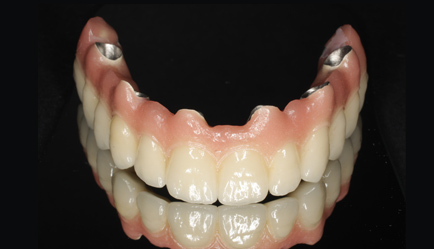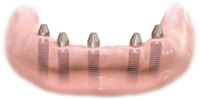Replacing all missing teeth
Should you be missing all of your teeth in the upper or lower jaw, dental implants are the best solution. You can choose a full bridge that is attached to several dental implants or another option is a removable prosthesis that is attached via anchoring devices to two or more dental implants. This prosthesis remains securely in place in your mouth, however it is easy to remove.
Missing All Teeth Case 1
Cosmetic Implant Supported Overdenture
This patient had a loose unattractive full upper denture. Providing a beautifully crafted cosmetic dentures supported on four implant routes completely solved the looseness allowing the patient to eat with confidence. Recreating the lip support produced a beautiful smile.



Missing All Teeth Case 2
Having no natural upper teeth this patient wanted a fixe solution, not a denture. computer guided surgery was used to place six implant roots. The exceptional skill of world class ceramist recreated the missing teeth and gums in porcelain (the final bridge is shown out of the mouth before fitting).


Treatment overview
1. A thorough examination
The first step we undertake in relation to dental implant therapy is to sit down and discuss your aims and concerns for the objectives of your treatment. We take a complete x-ray of your jaw to check the condition of the bone tissue and to determine the placement of the dental implant. We make an accurate impression of your jaw and existing teeth, this forms an important platform for the treatment.
2. Inserting the dental implant
There are two options for the dental implant placement, the choice of these is heavily dependant upon your clinical situation. The first option is the one-step procedure, this requires the dental implant to be put in place and a temporary abutment is attached. The second option is the two-step procedure, the dental implant is installed and then we cover it with the gum. The abutment is attached at a later date.
In both cases, a temporary tooth or prosthesis is put in place, this is followed by a maximum healing period of three months for the lower jaw and six months for the upper jaw. In some cases, the new dental implant can be loaded immediately although this does depend on the condition of your bone.
3. Attaching the abutments
In the case of the one-step procedure, after the dental implant has bonded with the bone tissue the temporary abutment is replaced by a permanent one. The two-step procedure requires a second stage which involves us making a minor incision into the gum to open it up and put the abutment in place.
4. Crafting the tooth
Once the abutment is in place, a new impression is made, we then compare it with the impression we made during the initial examination. From this examination we develop a final model of your jaw and implant, our experienced dental technician carefully crafts the crown, bridge or prosthesis that will sit on top of the implant. Considerable time and attention is spent ensuring we match the right colour and shape of your new teeth so they blend naturally with your existing teeth to create your new smile.
5. Fitting and re-examination
Once the carefully crafted tooth has been created and examined by us, we attach it to the dental implant. We follow up any implant procedure with a few follow-up visits to check the functionality and aesthetics and to make sure you are completely satisfied with your new tooth.
6. Healing period
An important factor in the healing period is the general state of health and the quantity and quality of your bone tissue. These factors determine the total duration of the treatment. We will be able to give you an indication of your specific situation from our initial detailed examination.
Replacing all missing teeth stages

Step 1
Should you have lost all your teeth in one or both jaws, we install a permanently anchored dental implant bridge or a removable prosthesis that is connected to two or more dental implants, this is called an overdenture. This type of overdenture dental implant solution remains in place more firmly than a conventional removable prosthesis. This is the most natural looking solution, and provides a more comfortable, less hassle and more secure natural looking teeth replacement solution.


Step 2
To achieve a permanently anchored dental implant bridge, several dental implants are installed to form a stable foundation. Because the dental implants are anchored in the jawbone, they stimulate the bone tissue and help to maintain healthy bone levels and facial structures.
An overdenture involves installing two or more dental implants that will be used as a secure foundation to attach the prosthesis.


Step 3
The abutments are attached to the dental implants and the bridge is fitted in place. We then spend time ensuring that you are happy with the new smile we created and that it looks natural.
For the overdenture, either ball abutments or a small bar between the abutments are used. The prosthesis is fitted with corresponding devices underneath.

Step 4
The dental implant bridge, or the overdenture, is now in place, it looks and functions like normal teeth. Once the dental implant has been installed you can confidently eat whatever you like and laugh without having to worry about the prosthesis falling out.
Get in touch
If you would like to discuss Dental Implant treatment options, please fill in the form below:





